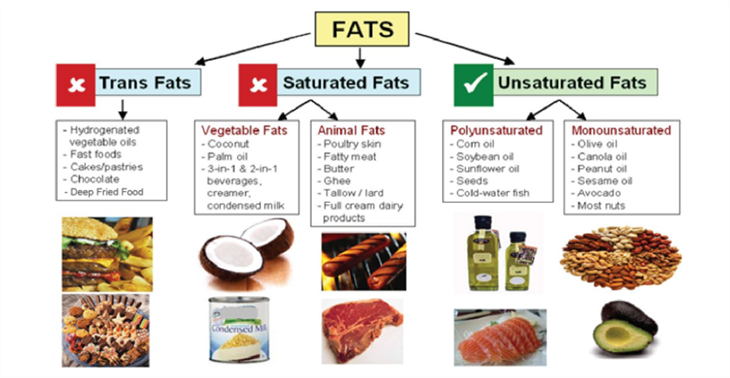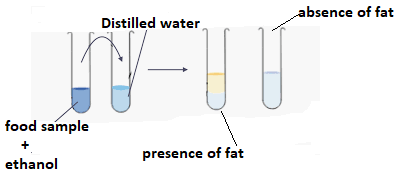
PUMPA - SMART LEARNING
எங்கள் ஆசிரியர்களுடன் 1-ஆன்-1 ஆலோசனை நேரத்தைப் பெறுங்கள். டாப்பர் ஆவதற்கு நாங்கள் பயிற்சி அளிப்போம்
Book Free DemoFats are also energy providers which keep us healthy and active. It provides more energy than carbohydrates. But fat-rich foods, when taken in greater quantity, will lead to a lot of health complications. Sources of fats include butter, ghee, cheese, milk, paneer, meat, nuts, fish, egg yolk etc.
Fats also insulates the body and protects the cells. There exists good fats and bad fats. Good fat includes unsaturated fats, which are polyunsaturated and monounsaturated fatty acids. Monounsaturated fatty acids are present in nuts, peanut butter, almond butter, and vegetable oils.
Bad fats include trans fats and saturated fats, which are found in higher quantity in French fries, baked foods (cakes, pastries) and processed snacks. The diagram below gives a list of good and bad fats.

Classification of fats
Activity to test the presence of fat:
Aim:
To test the presence of fat in the given food item.
Materials required:
Vegetable oil like coconut oil, groundnut oil, gingelly oil, and some paper.
Procedure:
1. Pour a few drops of oil onto the paper and rub it gently with your finger.
2. If using nuts like groundnut, crush the groundnut and place it on paper.
3. Rub the groundnut gently on the paper.
Observation:
The paper turns translucent and becomes greasy.
Inference:
The given food sample contains fat.
The video below displays the test for fat:
Another test for fats:
Crush the food containing fat if the food sample is solid and mix it with ethanol, or simply mix the liquid sample with ethanol to get a clear liquid (a solution of fat in ethanol). Add this to a test tube of water.
A white (milk-like) emulsion indicates the presence of fats or oils.

Protein:
Our body needs proteins for growth, repair, and other body functions like digestion. It gives structure and support to our cells. Proteins are the building blocks of the body. They are usually considered as "healthy foods".
Hence, people suffering from various health issues prefer taking more protein-rich food as a replacement for carbohydrates. Sources of protein include pulses, eggs, chicken, fish, nuts, soya bean, grams, sprouts and milk.

Sources of protein
Activity to test the presence of proteins:
Aim:
To test the presence of protein in the given food.
Materials / Chemical required:
Egg white, Copper sulphate solution, Sodium hydroxide, Bunsen burner and test tube.
Procedure:
1. Take a small amount of food sample (Egg white in this case) and put it in a test tube.
2. Add water to the contents of the test tube and shake well.
3. Heat the test tube for 1 minute.
4. After the test tube cools down, add about 2 drops of Copper sulphate solution and Sodium hydroxide to it.
Observation:
The food sample turns violet or purple in colour.
Inference:
The change in colour to purple or violet confirms the presence of protein in the food.
The following video displays a test for protein in milk and salt solution:
Reference:
https://socratic.org/questions/what-should-you-use-to-test-if-a-type-of-food-has-starch-sugar-or-fat